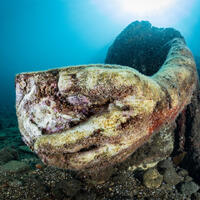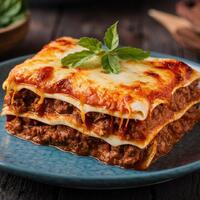gorgonzola is named after the town of Gorgonzola, near Milan in the Lombardy region, where it was first produced. The history of Gorgonzola cheese is full of legends and stories that support its rich heritage. According to one legend, the cheese was discovered by chance by a shepherd near Gorgonzola. He forgot a piece of cheese in the field and when he returned, he discovered a blue mould. He decided to taste the cheese and was delighted by its taste. This is considered to be the beginning of Gorgonzola production.
Gorgonzola is made from pasteurised cow's milk. First, the milk is soured and a culture of lactic bacteria and animal rennet are added. This mixture is left to ferment for up to 24 hours. The curd is then cut into small pieces and gradually filled into moulds. During the process, the cheese is pierced to allow air to penetrate, which encourages mould growth. Once fully matured, which usually takes between 8 and 12 weeks, the Gorgonzola becomes light cream and develops its characteristic blue veined pattern. The moulds responsible for this pattern are present only in the interior of the cheese. The wind and humidity in the Lombardy region contribute to the formation of these moulds, giving Gorgonzola its unique taste and aroma.
There are two varieties of Gorgonzola - Gorgonzola Dolce (sweet) and Gorgonzola Piccante (sharp). Gorgonzola Dolce is milder and has a creamy consistency with a slightly sweeter profile. Gorgonzola Piccante is stronger and more pronounced, with spicy notes.
Italy is still the main producer of Gorgonzola, especially from the Lombardy and Piedmont regions. Many family farms specialise in the production of this cheese and it is also produced by large dairies and cheese factories. Gorgonzola is exported all over the world and has become a popular ingredient in many dishes such as sauces, pasta, salads and pizzas.
Gorgonzola is an exceptional cheese with a rich history and a unique flavour profile. Its blue veined core adds not only visual aesthetics to the dish, but also an intense and savoury flavour experience. If you are a cheese lover, Gorgonzola should definitely not be missing from your tasting experience.

Here are a few tips on how to use it:
-
Cheese sauces: Gorgonzola is often used to make cheese sauces. It can be melted with butter, cream and other ingredients to create a rich and creamy sauce that is served with pasta, rice or roasted meats.
-
Pasta: Gorgonzola is a great ingredient for pasta dishes. It can be melted into cream or tomato sauce to create a delicious and rich sauce. It is often used in combination with nuts, spinach or sweet pears to create a contrast of flavours.
-
Salads: Gorgonzola is often cut into small pieces and added to salads to bring rich flavour and texture. It is a great ingredient for salads with sweet fruits such as pears, grapes or strawberries. Combining raw Gorgonzola with savory vegetables such as radish or arugula is also popular.
-
Pizza: Gorgonzola is often used as one of the ingredients on pizzas. Its strong flavour combines well with other ingredients such as ham, bacon, onions, tomatoes or figs. It is often spread over the surface of the pizza, where it melts as it bakes, creating a sweet and savoury combination.
-
Desserts: although Gorgonzola is typically seen as a cheese for savoury dishes, some chefs also use it in desserts. Its rich and sweet flavour pairs well with fruits such as pears, figs or dates. Gorgonzola can be part of a cheese platter or served with honey and nuts as a final course.







